Positive Health Online
Your Country

The Alexander Technique
listed in alexander technique, originally published in issue 19 - April 1997
Many people who come to me for lessons who have been to other teachers say: "you're not like my other Alexander teachers!" I think this is because my route through years of having lessons, and through the three years of training was a very bumpy one. I was bewildered, amazed, mystified, irritated, bored, resentful and fascinated in turns. I know now that I was a very difficult pupil: in constant pain, stubborn, hectic and nervous. But it seemed to me that I would never get 'it', even though my chronic back trouble began to clear up, and I could certainly tell that there was something of great value in the work.
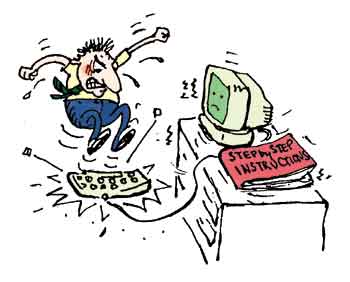
Perhaps the stuborness did help after all!!
I wondered when some teacher would tell me what was going on in clear ringing tones, but I hoped in vain. Once I was told: "If you don't stop trying, you might as well stop coming for lessons". As a New England workaholic, this was a statement that needed clarification! An aura of tantalising mystery hung over the work, and I felt I was a failure, a dud, doomed to be forever an outsider, peering through misted windows trying to see the message, but never quite managing to. At that time, the early 1970s, there were no well written, accessible books on the Technique as there are today. Looking back over all those years I wonder how I persevered. Perhaps the stubbornness did help after all.
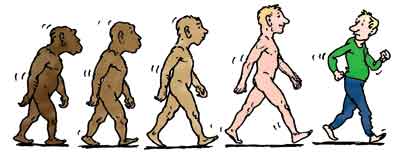
Alexander believed that the pace of technological and social change
has rushed ahead of our reflex and postural systems
When I qualified as a teacher in 1984, I was lucky to be able to start teaching in a practice room in the Music Department of Exeter University, where on the advice of another teacher I set myself to rediscover the Technique for myself, and having done that, to discover how all the specialised Alexander vocabulary could be explained in simple English. I wanted to offer 'The Definitive Moron's Guide' that I myself had needed so badly! I also wanted to inject some humour into what was generally an all too serious discipline. I have always found that an image is indeed worth a thousand words, and a funny one worth two thousand; and being a talkative sort of person, I chose to develop verbal explanation as well as images, and add them to the chair and tablework that are an integral part of a classical Alexander lesson.
In this article I would like to go over the main themes that form the foundation of the Alexander Technique, and explain them to you in a way that I hope will make them clear, and demonstrate their pertinence for all of us today.
"Lucy was my 5th Alexander teacher. Everyone's style is different, but I have found her very practical, informative, and helpful for my bad back, and great fun to learn from. Her version of the Alexander Technique has a lot of 'hints and tips' so that I can understand it. With others there's a lot of mystification, or it's just too subtle for me! I have been able to learn how to dig in the garden, and lift heavy children in a way that doesn't hurt my back. My husband even brought his windsurfing board and sail to a lesson for advice on balance!" Mary Quicke, Quicke Cheeses
Our use of ourselves and the nature of habits
Alexander believed that the pace of technological and social change has rushed ahead of the evolution of our reflex and postural systems. This means that we are ill equipped to cope with the stresses and strains of modern life. They tug us out of shape and compress us in various ways, and in the long run cause many of the chronic health problems that seem to haunt so many of us.
According to Alexander the only way to reverse this downward spiral was for us to bring our 'use' of ourselves into our conscious awareness, and devise ways of taking care of ourselves based on this awareness. He urged us all to step away from our habitual instinctive reactions and to give ourselves space for a new and appropriate way of responding to life. When he used the word 'use' he meant not just our posture and way of walking, bending and so on, but also our way of reacting to anything that came our way in life.
An Alexander expression that follows on from this is 'use affects functioning'. This simply means that the way you use yourself in the everyday activities of your life will affect your health. A student sitting slumped over a desk, then on a sofa, then on a barstool, has starved his/her brain of oxygen, compressed the digestive system, impaired the breathing, put pressure on the joints . . . the list could go on. If this manner of use, or way of being, is chronic, functioning will be affected and health problems will follow.
"Since my Alexander lessons I have become more aware of my posture, and this has been an invaluable first step to correcting my bad postural habits. I am a tall person who has had rounded shoulders and tended to collapse my spine in the middle when sitting. This led to tightness around the shoulders and in the middle of the chest and to long term digestive problems. The lessons are relaxing, and the adjustments very gentle. I was put at my ease and Lucy showed me simple but effective ways of avoiding and correcting my problems. Lucy's helpful advice, professionalism, and friendly manner has made a difference to my life that I did not at first expect, but was pleasantly surprised to discover." Laurence Orrell, Massage Therapist
'Faulty sensory perception' is one of the most important discoveries that Alexander made in the evolution of his technique. It means that we actually don't know what our posture, our style, is. We read ourselves incorrectly. Anything that you do repeatedly becomes a habit, and the nature of a habit is that you are unaware of it. Have you ever found yourself walking down a shopping street feeling quite straight and normal, only to glance into a shop window, see a stooping hunched stranger, and realised to your horror that it is you? We all have a host of habits that we aren't aware of. It's your life itself that is reflected in your use.
It is vitally important that you realise however, that looking in a mirror and pulling yourself into a shape you like the look of better, and then trying to maintain it, will never work. Habits have to be approached with great respect, perseverance, and subtlety. They have enormous power over us, and unless we stop and look at them quietly, and say "oh there you are", in a peaceful accepting way, we won't be able to move ahead towards change.
"After several appointments with the physiotherapist to help with a neck problem, she suggested I might try the Alexander Technique. I was, to say the least skeptical when I booked my first session. However, I did not wish to appear 'stick-in-the-mud' especially if I needed to ask the physiotherapist for help again! Within 30 minutes of the start of the first session, I realised how much the Alexander Technique could help me. I became aware of my poor posture and some habits I did not even realise I had! The Alexander Technique not only started to help me correct my posture during everyday activities but also to increase my body awareness while pursuing my hobby of horse riding. It helped me to address positional faults and general tension, by focusing on the present, not the past and future. The images used by my teacher during the lessons enabled me to remember the Technique throughout my daily living. The Alexander Technique is something which one can think about and apply no matter how busy or difficult life becomes.'" Clare Landymore, GP Practice Manager
The Primary Control or The head/neck/back relationship
Alexander discovered that the way the head balances on the neck, and in turn the relationship of the head to the neck and the back, are primary, or vital, to poised and balanced use of the self. He called this "The Primary Control".
Your head is very heavy; it weighs between 10 and 12 pounds. Pick up a bag of potatoes or some other such thing weighing 10 pounds, and you will be amazed at its weight. Clearly it is most important that it sits lightly and easily on top of your neck, and also your whole back needs to be in its proper alignment for all to be well. Most of us have chronically tense necks, and this has a definite compressing and discoordinating effect, but most of us are completely unaware of it. Even if you came to lessons for painful knees, your teacher will work on your primary control! In the case of your knees, if your head and spine are out of true, your knees will be working very hard to hold you up.
Doing and non-doing
The expression 'Non-doing' is one often used in Alexander lessons. It is used to describe a variety of things that nevertheless have a common theme. It can be confusing: how can one change the habits of a lifetime, and yet do nothing? How can you get to the right way, without trying to be right? These were questions that bothered me as a pupil.
The Alexander teacher's hands are meant to convey a quietness to the pupil, to have a calming effect to the whole system, and to gently guide the pupil towards a better alignment, a more lengthened and toned state, and to more skillful use. Our job is to offer information with our hands that is not a judgement, but rather a choice. Non-doing is definitely not nothing doing!
The instruction not to 'do' or put yourself into a position, or to try to be right, is needed because of our faulty sensory awareness. Our habits of contraction, distortion, and collapse, as I said above, have become so familiar to us that we stop feeling them as wrong. They come to feel normal, right, and even comfortable. Obviously this will cause some confusion when the Alexander teacher guides you into a new alignment; it is bound to feel wrong, awkward, crooked, at first. Thus it can't help to try and be right by doing what feels right, while your sensory feedback is still poor, because that attempt will automatically lead you back where you started. Frustration! The task, and it is a hard one, is not to actively do anything, but to allow yourself to just wait and see. This is non-doing on the part of the pupil.
Another way in which it is wrong to try to 'do', is to try to be right. This is more of a mental attitude, and an area where I stumbled and fell for ages. If you think of "really trying hard" you will almost always tense your body, and fix your head tightly on your neck, thus compressing your spine. The Alexander Technique encourages a calm and easy freedom in the approach to any task.
You cannot achieve anything but harm if you throw yourself into a position hoping it is better and hold yourself there, or if you try to force your shoulders back, pull up your chest and brace your knees in that all too familiar 'stand up straight' mode. It's the despair of Alexander teachers when they tell someone they teach the Technique, and the response is "Oh dear, I'd better stand up straight then". They then only add more contraction and tension. It's a very upsetting sight!
Inhibition and direction
What high levels of confusion these two words create in many Alexander pupils! They certainly did in me. However, we are at the very heart of the Alexander Technique, and it is vital to understand what they mean.
Alexander coined the word inhibition before all the connotations of inhibited, suppressed and repressed became part of our vocabulary. These words have coloured our feelings about the word inhibition, and I feel therefore that it is time to move on to other ways of expressing this concept. I suggest that my pupils think of activating an observer in themselves, a part of their attention that stops and looks at the quality of the moment completely without judgement, and that inhibition is in fact no more, and no less, than paying attention to this present moment.
I ask them, for example, not to get ready to stand when they are sitting, but to just be there. This is inhibition. Unless you stop and allow yourself to be attentively quiet, you will remain a slave to your habits, and won't be able to really change. You can't change the way you do anything by just adding on another layer of doing, leaving the old patterns and habits intact.
Directions are the mental instructions you give yourself having stopped to pay attention and allow space for change. I find this word is also confusing to most people. I use instead the word intention, or focused intention. The mind is enormously powerful, and it can indeed make changes happen. A clear intention to release tension, or to lengthen the back, is effective; an attempt to do it in a muscular way is not. I have found the substitution of attention and focused intention for inhibition and direction very helpful to my pupils.
The classic Alexander 'directions' as stated by Alexander, and presented by many Alexander teachers are as follows: "Neck to be free, Head to go forward and up, Back to lengthen and widen". These are designed to work on the primary control. I seldom use these specific words, as I find them obscure. I do use many other ways and means to convey the information, and part of the work of the lessons is to find the exact images and thoughts that work for each individual.
The following are the instructions for focused intentions that I have found most useful.
Neck to be free, Head to go forward and up: If you think of the release of tension in your neck happening SO THAT your head can rotate very gently forward, you can see that the two instructions are really a single event. Make a fist and push it tightly backward. This is similar to your head on your neck when it is tense. Now soften this tension, and you will see that your fist rotates forward gently, and comes up. This is what the instruction 'forward and up' means.
Back to lengthen and widen: Think of an arrow of energy going up your back to the top of your spine, with your head releasing, 'noddable' at the top. Imagine that you have gill slits in the lower ribs at the sides and back, and now think of breathing in through these slits rather than through your nose. This will widen your back and deepen the breathing.
Endgaining and the Means Whereby 'Endgaining and the means whereby' is a very dated phrase of Alexander jargon which nevertheless is basic to the Alexander Technique. It takes the Technique out of the realm of body/mind work, and moves it closer to a way of thinking, or even living. 'Endgaining and the Means Whereby' is an abstract idea, but it is something that can be applied to any problem, and is one of the most important principles of the Technique.
When he used the expression 'Endgaining', Alexander meant rushing towards a goal, without any attention to the manner of achieving it. I think we all know too much about this! Our whole society is geared to endgaining, in some areas it is considered a definite virtue. However, it is clear to us all now, as it was clear to Alexander 80 years ago, that if we do not start to take care of the way we move towards our goals in all areas of our public and private lives, as individuals, and as members of the human race, we will have very little future to look forward to at all.
"The end justifies the means" is a way of thinking absolutely opposite to that of the Alexander Technique, which says instead: "If you pay attention to the means, the end will take care of itself." Thus the process becomes more important for achieving any goal. When we practice inhibition (or attention) and direction (or intention), this is what we are trying to do. Eventually we will be able to incorporate the improvements that take place into any activity, and profoundly affect the quality of anything we are doing.
This paying attention to the means, to the moment, is a part of the teaching of all of the great religions and philosophies of the world, as well as all psychotherapeutic disciplines. The Buddhist concept of 'mindfulness' is just one example of a similar way of thinking, and many people believe that being fully aware in the moment is one of the secrets of happiness. Most of us live both ahead of and behind ourselves, our minds ranging about in the past or in the future, and we have virtually no awareness of the present moment.
The Alexander Technique, although subtle, is always practical, and it offers a definite skill that allows us greater awareness as we move through each day. The process of inhibition (attention), and direction, (focused intention), allows us access to what is happening in our bodies and minds at any moment in time. It is a kind of meditation in activity.
And finally, a practical hint: The semi-supine position. This is a fancy way to say "lie down on the floor!" It is considered the position of maximum rest for the spine, and also a way for driven people to begin to slow down, to pay attention at last. If the floor is too hard, use a mat, but make sure it is as unforgiving a surface as you can lie comfortably on. Get down on you hands and knees, and roll sideways onto your back and do the reverse to get up. Keep your knees bent, and put enough books under your head so that it doesn't rock back, and your chin tip up. Then just stay there for 20 minutes. If you are thinking of having lessons, this is a good way to check and see if you would benefit. If you find it hard to just stay put for 20 minutes without doing anything, you are a prime candidate! If you also find that it eases your back/neck/shoulders etc. then you should seriously consider lessons.
"I came to the Alexander Technique at the point of desperation with continual and rapidly worsening pain from my arthritic neck, and was about to give up my regular wilderness hiking because of it. The Alexander Technique not only immediately saved my hiking, and saved me from the neck trouble, but also through full integration into my life it has transformed every corner of my life experience. In walking, and indeed in other body movements I now have a wonderful sense of ease and lightness, This state is in the mind too, so that I have much enhanced mental clarity and the ability to let go of unhelpful reactive thoughts and emotions, which means that I produce better considered and more appropriate responses to situations, and am able to achieve more with less trying." Phillip Goddard, Composer and Author
I hope that this information has helped to demystify the essence of the Alexander Technique for you. The other ways of describing it that I have discussed are my own adaptations, which work well for me and my pupils. Other Alexander teachers will have discovered their own ways of working, and I believe that as long as each of us works with honesty and goodwill, we each have a lot to offer.
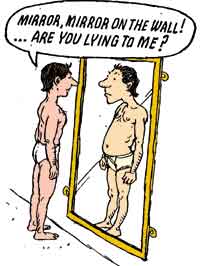
We read ourselves incorrectly
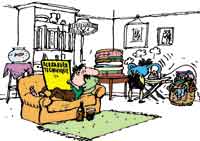
The Alexander Technique encourages a calm and easy freedom in the approach to any task

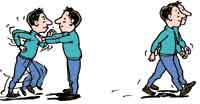
You need to stop rushing and work with yourself
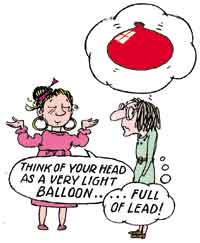
The right images for each person are very important
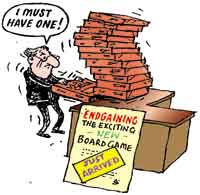
Rushing towards a goal without any attention to the manner of achieving it
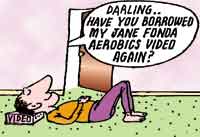
Artist: Norman Young
Comments:
-
No Article Comments available